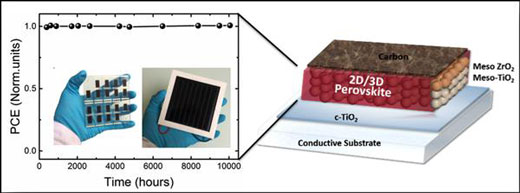| Posted: Jun 01, 2017 |
Ultra-stable perovskite solar cell remains stable for more than a year
(Nanowerk News) Perovskite solar cells promise cheaper and efficient solar energy, with enormous potential for commercialization. But even though they have been shown to achieve over 22% power-conversion efficiency, their operational stability still fails market requirements. Despite a number of proposed solutions in fabrication technology, this issue has continued to undercut whatever incremental increases in efficiency have been achieved.
|
|
EPFL scientists have now built a low-cost, ultra-stable perovskite solar cell that has operated for more than a year without loss in performance (11.2%). The work is published in Nature Communications ("One-Year stable perovskite solar cells by 2D/3D interface engineering").
|
 |
| This is a schematic representation of the findings of this study. (Image: MK Nazeeruddin/EPFL)
|
|
The lab of Mohammad Khaja Nazeeruddin at EPFL in collaboration with Michael Grätzel and Solaronix company has engineered what is known as 2D/3D hybrid perovskite solar cell. This combines the enhanced stability of 2D perovskites with 3D forms, which efficiently absorb light across the entire visible spectrum and transport electrical charges.
|
|
In this way, the scientists were able to fabricate of efficient and ultra-stable solar cells, which is a crucial step for upscaling to a commercial level. The 2D/3D perovskite yields efficiencies of 12.9% (carbon-based architecture), and 14.6% (standard mesoporous solar cells).
|
|
The scientists built 10x10 cm2 solar panels using a fully printable industrial-scale process. The resulting solar cells have now delivered a constant 11.2% efficiency for more than 10,000 hours, while showing zero loss in performance as measured under standard conditions.
|
|
The breakthrough resolves the problem of perovskite solar-cell stability, and can viably move the technology into the commercial sphere.
|

